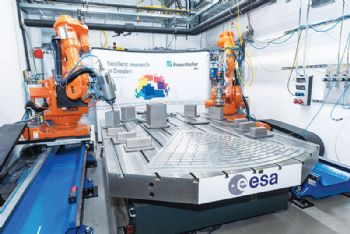
Twin robotic arms are working together on a project to construct what will be the largest and most complex object ever 3-D printed in titanium: a test version of the 3m-diameter ‘optic bench’ at the heart of ESA’s Athena X-ray observatory (
www.esa.int).
The first multi-axis robotic arm builds up each new layer of metal using a laser to melt titanium powder. The second robotic arm then immediately cuts away any imperfections, using a cryogenically cooled milling tool. The bench itself is placed on a slowly moving 3.4m-diameter turntable.
Materials and processes engineer Johannes Gumpinger said: “ESA has teamed up with Germany’s Fraunhofer Institute for Material and Beam Technology for this exploratory activity.
"The final design of Athena’s optic bench is still to be decided, but if it is built in titanium, it’s size and complexity are such that it will have to be built using AM.”
Due to launch in 2031, ESA’s Athena mission will probe 10- to 100-times deeper into the cosmos than previous X-ray missions to observe the very hottest high-energy celestial objects.
It requires entirely new X-ray optics technology, with stacks of ‘mirror modules’ arranged carefully to capture and focus high-energy X-rays.
The optic bench aligns and secures around 750 mirror modules in a complex structure with many deep pockets that tapers out to a maximum height of 30cm. Its overall shape needs to be precise down to a mere few tens of microns.
André Seidel, overseeing the project at the Fraunhofer Institute (
www.fraunhofer.de), said: “The optic bench’s complexity requires each addition to be milled immediately after printing.
"Any subsequent modification could risk introducing contamination, weakening the space-quality titanium. Similarly, the entire process has been designed to minimise any risk of contamination.
"The titanium powder is swept into the laser using the noble gas argon, which prevents any contamination with air, and the milling tool is kept cool using liquid CO
2 that evaporates as it warms up, preventing any harmful deposition on the freshly laid metal surface.”
Precision sensors immediately detect any out-of-tolerance elements for milling or more extensive repair, including milling away for reprinting.
Smaller segments have been made so far, with a 1.5m-diameter demonstrator optic bench set to follow. The full-scale 3m bench is expected to take about a year to produce.
Mr Gumpinger added: “It will be a huge task, taking a lot of time and energy, but if we succeed, it will be the largest titanium object ever 3-D printed — and the process will be available to manufacture other large parts, potentially in other metals.”
The project is being supported through ESA’s Technology Development Element as part of the Agency’s Advanced Manufacturing initiative, harnessing novel materials and processes for the space sector.